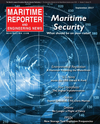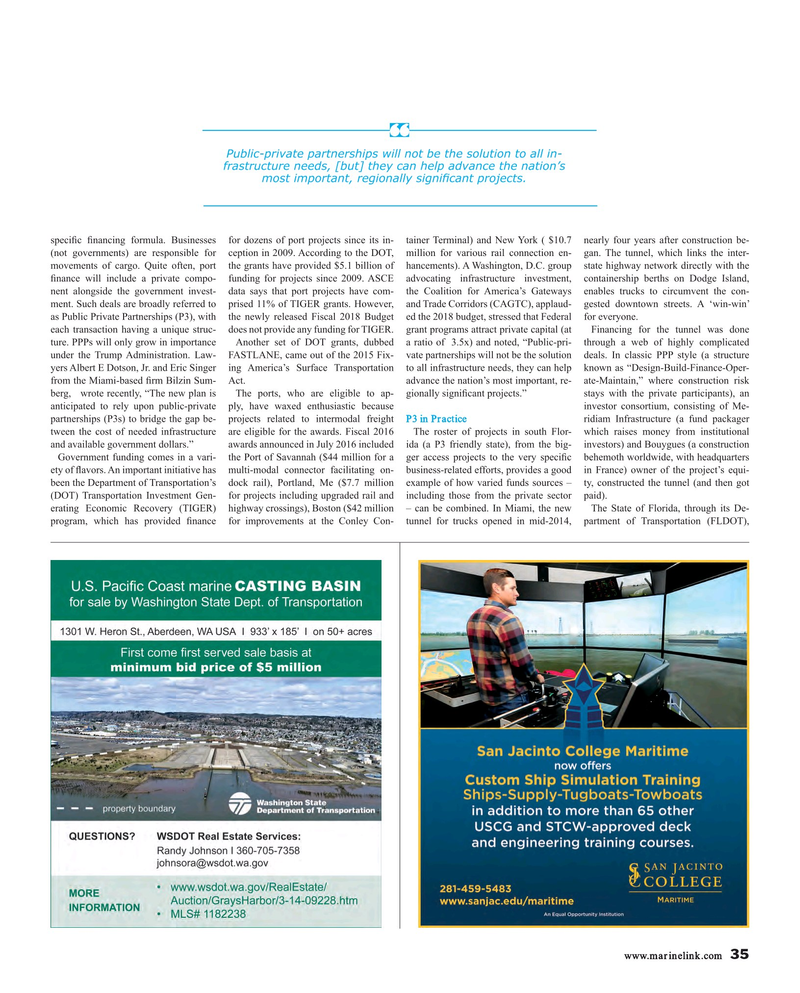
Page 35: of Maritime Reporter Magazine (September 2017)
U.S. Navy Quarterly
Read this page in Pdf, Flash or Html5 edition of September 2017 Maritime Reporter Magazine
“
Public-private partnerships will not be the solution to all in- frastructure needs, [but] they can help advance the nation’s most important, regionally signi? cant projects.
speci? c ? nancing formula. Businesses for dozens of port projects since its in- tainer Terminal) and New York ( $10.7 nearly four years after construction be- (not governments) are responsible for ception in 2009. According to the DOT, million for various rail connection en- gan. The tunnel, which links the inter- movements of cargo. Quite often, port the grants have provided $5.1 billion of hancements). A Washington, D.C. group state highway network directly with the ? nance will include a private compo- funding for projects since 2009. ASCE advocating infrastructure investment, containership berths on Dodge Island, nent alongside the government invest- data says that port projects have com- the Coalition for America’s Gateways enables trucks to circumvent the con- ment. Such deals are broadly referred to prised 11% of TIGER grants. However, and Trade Corridors (CAGTC), applaud- gested downtown streets. A ‘win-win’ as Public Private Partnerships (P3), with the newly released Fiscal 2018 Budget ed the 2018 budget, stressed that Federal for everyone.
each transaction having a unique struc- does not provide any funding for TIGER. grant programs attract private capital (at Financing for the tunnel was done ture. PPPs will only grow in importance Another set of DOT grants, dubbed a ratio of 3.5x) and noted, “Public-pri- through a web of highly complicated under the Trump Administration. Law- FASTLANE, came out of the 2015 Fix- vate partnerships will not be the solution deals. In classic PPP style (a structure yers Albert E Dotson, Jr. and Eric Singer ing America’s Surface Transportation to all infrastructure needs, they can help known as “Design-Build-Finance-Oper- from the Miami-based ? rm Bilzin Sum- Act. advance the nation’s most important, re- ate-Maintain,” where construction risk berg, wrote recently, “The new plan is The ports, who are eligible to ap- gionally signi? cant projects.” stays with the private participants), an anticipated to rely upon public-private ply, have waxed enthusiastic because investor consortium, consisting of Me- partnerships (P3s) to bridge the gap be- projects related to intermodal freight P3 in Practice ridiam Infrastructure (a fund packager tween the cost of needed infrastructure are eligible for the awards. Fiscal 2016 The roster of projects in south Flor- which raises money from institutional and available government dollars.” awards announced in July 2016 included ida (a P3 friendly state), from the big- investors) and Bouygues (a construction
Government funding comes in a vari- the Port of Savannah ($44 million for a ger access projects to the very speci? c behemoth worldwide, with headquarters ety of ? avors. An important initiative has multi-modal connector facilitating on- business-related efforts, provides a good in France) owner of the project’s equi- been the Department of Transportation’s dock rail), Portland, Me ($7.7 million example of how varied funds sources – ty, constructed the tunnel (and then got (DOT) Transportation Investment Gen- for projects including upgraded rail and including those from the private sector paid).
erating Economic Recovery (TIGER) highway crossings), Boston ($42 million – can be combined. In Miami, the new The State of Florida, through its De- program, which has provided ? nance for improvements at the Conley Con- tunnel for trucks opened in mid-2014, partment of Transportation (FLDOT), www.marinelink.com 35
MR #9 (34-41).indd 35 MR #9 (34-41).indd 35 9/7/2017 9:36:51 AM9/7/2017 9:36:51 AM

 34
34

 36
36
